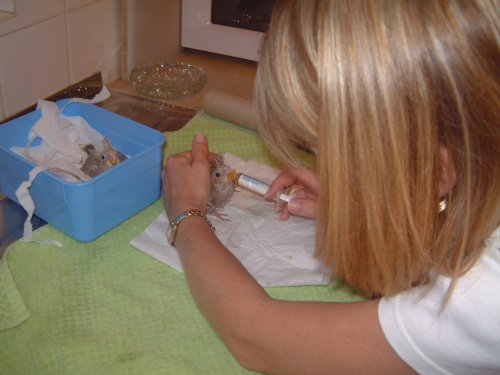|
|
|
 Hand feeding itself is an uncomplicated process. A dry formula called Kaytee
exact® Hand Feeding formula is mixed with hot, clean water to a desired
consistency (it is extremely important to follow the directions completely and
thoroughly), and then, using a spoon, tube or preferably a special syringe, it
is fed to the hungry baby. When a chick hatches from the egg, it must be fed
about every two hours. As the baby grows and matures, the number of feedings
decrease and the amount of food fed increases. In general, baby birds require
10-12% of their body weight per feeding! Critical elements to remember are to
use fresh formula at each feeding, use proper hygiene, and monitor babies daily
for growth and health.
Hand feeding itself is an uncomplicated process. A dry formula called Kaytee
exact® Hand Feeding formula is mixed with hot, clean water to a desired
consistency (it is extremely important to follow the directions completely and
thoroughly), and then, using a spoon, tube or preferably a special syringe, it
is fed to the hungry baby. When a chick hatches from the egg, it must be fed
about every two hours. As the baby grows and matures, the number of feedings
decrease and the amount of food fed increases. In general, baby birds require
10-12% of their body weight per feeding! Critical elements to remember are to
use fresh formula at each feeding, use proper hygiene, and monitor babies daily
for growth and health.
After feeding, baby birds love to sleep. Some birds sleep on their backs, some sleep lying flat and some sleep with their head in what looks like uncomfortable positions. This is all perfectly normal. In the wild, they are cramped in often very small cavities in a tree, so being in a small place is actually more comfortable to them than if they were kept in a very large enclosure. Further, being kept relatively confined helps normal leg development.
When a baby bird learns to eat by itself, it is called weaning. While birds vary, most wean at 8-12 weeks. This means that most birds reach their adult size and weight by 3 months of age!
When a baby begins the weaning process, it explores its surroundings and also
learns to perch. It is often a difficult time for the baby and the hand feeder,
but with time and patience, the bird is soon doing well. In the wild, when the
baby leaves the nest cavity, it follows its parents around begging for food and
eventually tries food for itself.